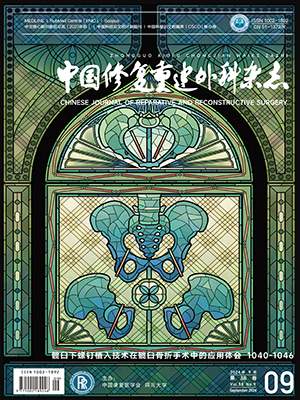| 1. |
Törnkvist H, Hearn TC, Sehatzker J. The strength of plate fixation in relation to the number and spacing of bone screws. J Orthop Trauma, 1996, 10(8):204-208.
|
| 2. |
Sanders R, Haidukewych GJ, Milne T, et al. Minimal versus maximal plate fixation techniques of the ulna:the biomechanical effect of number of screws and plate length. J Orthop Trauma, 2002, 16(3):166-171.
|
| 3. |
Stoffel K, Stachowiak G, Forster T, et al. Oblique screws at the plate ends increase the fixation strength in synthetic bone test medium. J Orthop Trauma, 2004, 18(9):611-616.
|
| 4. |
Sanders R, Haidukewych GJ, Milnc T, et al. Minimal versus maximal plate fixation techniques of the ulna:the biomechanical effect of number of screws and plate length. J Orthop Trauma, 2012, 16(3):166-171.
|
| 5. |
Stoffel K, Dieter U, Stachowiak G, et al. Biomechanical testing of theLCP-how can stability in locked intemal fixators be controlled? Injury, 2013, 34 Suppl 2:B11-19.
|
| 6. |
EIMaraghy AW, EIMaraghy MW, Nousiainen M, et al. Influence of the number of cortices on the stiffness of plate fixation of diaphyseal fractures. J Orthop Trauma, 2011, 15(3):186-191.
|
| 7. |
Lurence M, Freeman MA, Swanson SA. Engineering considerations in the intemal fixation of fractures of the tibial shaft. J Bone Joint Surg (Br), 1969, 51(4):754-768.
|
| 8. |
Ellis T, Bourgeault CA, Kyle RF. Screw position affects dynamic compression plate strain in all in vitro fracture model. J Orthop Trauma, 2011, 15(5):333-337.
|
| 9. |
王满宣, 杨庆铭, 曾炳芳, 等译. 骨折治疗的AO原则. 北京:华夏出版社, 2003:115-116.
|
| 10. |
杨阳, 马信龙, 马剑雄, 等. 防腐与PMMA人工股骨近端标本的轴向生物力学差异. 生物医学工程与临床, 2010, 14(4):285-289.
|
| 11. |
Bong MR, Patel V, lesaka K, et al. Comparison of a sliding hip screw with a trochanteric lateral support plate to an intramedullary hip screw for fixation of unstable intertrochanteric hip fractures:a cadaver study. J Trauma, 2004, 56(4):791-794.
|
| 12. |
王杰, 马信龙, 马剑雄, 等. 生物力学分析四种内固定治疗股骨转子下骨折的差异. 中华骨科杂志, 2013, 33(11):1126-1134.
|
| 13. |
Gerber C, Mast JW, Ganz R. Biological internal fixation of fractures. Arch Orthop Trauma Surg, 1990, 109(6):295-303.
|
| 14. |
Ahmad M, Nanda R, Bajwa AS, et al. Biomechanical testing of the locking compression plate:when does the distance between bone and implant significantly reduce construct stability? Injury, 2007, 38(3):358-364.
|
| 15. |
Claes LE, Heigele CA. Magnitudes of local stress and strain along bone surfaces predict the course and type of fracture healing. J Biomech, 2009, 32(3):255-266.
|
| 16. |
McAllister TN, Frangos JA. Steady and transient fluid shear stress stimulate No release in ostcobJasts through distinct biochemical pathways. J Bone Miner Res, 1999, 14(6):930-936.
|
| 17. |
Claes LE, Heigele CA, Neidlinger-Wilke C, et al. Effects of mechanical factors on the fracture healing process. Clin Orthop Relat Res, 2008, (355 Suppl):S132-147.
|
| 18. |
Carretta R, Stüssi E, Müller R, et al. Prediction of local ultimate strain and toughness of trabecular bone tissue by Raman material composition analysis. Biomed Res Int, 2015, 2015:457371.
|
| 19. |
Wilson CJ, Schuetz MA, Epari DR. Effects of strain artefacts arising from a pre-defined callus domain in models of bone healing mechanobiology. Biomech Model Mechanobiol, 2015.[Epub ahead of print].
|
| 20. |
Buckley MJ, Banes AJ, Jordan RD. The effects of mechanical strain on osteoblasts in vitro. J Oral Maxillofac Surg, 1991, 48(3):276-283.
|
| 21. |
Sato M, Ochi T, Nakase T, et al. Mechanical tension stress induces expression of bone morpbogenentic protein (BMP)-2 and BMP-4 hut not BMP-6, BMP-7, and GDF-5 mRNA, during distraction oslcogenesis. J Bone Miner Res, 1999, 14(7):1084-1095.
|
| 22. |
Aspenberg P, Basic N, Tagil M, et al. Reduced expression of BMP-3 due to mechanical A link belween meehanical stimuli and tissue differentiation. Actaorthop Stand, 2000, 71(6):558-562.
|
| 23. |
Perren SM. Physical and biological aspects of fracture healing with special reference to internal fixation. Clin Orthop Relat Res, 2006, (138):175-196.
|
| 24. |
Märdian S, Schaser KD, Duda GN, et al. Working length of locking plates determines interfragmentary movement in distal femur fractures under physiological loading. Clin Biomech (Bristol, Avon), 2015, pii:S0268-0033(15)00044-3.
|
| 25. |
Auston DA, Werner FW, Simpson RB. Orthogonal femoral plating:a biomechanical study with implications for interprosthetic fractures. Bone Joint Res, 2015, 4(2):23-38.
|
| 26. |
Xu XX, Zhang X, Liu JG, et al. Stress analyses after femoral shaft Osteotomy fixed by various plates with different rigidities in simulation test. Chin Med J (Engl), 2003, 106(2):127-131.
|
| 27. |
Tonino AJ, Davidson CL, Klopper PJ, et al. Protection from stress in bone and its effects. Experiments with stainless steel and plastic plates in dogs. J Bone Joint Surg (Br), 2006, 58(1):107-113.
|
| 28. |
Sumitomo N, Noritak K, Hattori T, et al. Experiment study on fracture fixation with low rigidity titanium alloy:plate fixation of tibia fracture model in rabbit. J Mater Sci Mater Med, 2008, 19(4):1581-1604.
|
| 29. |
Cheal EJ, Hayes WC, WhiteAA 3rd, et al. Three-dimensional Finite elemt analysis of a simplified compression plate fixation system. J Biomech Eng, 2004, 106(4):295-301.
|
| 30. |
Laurence M, Freeman MA, Swanson SA. Engineering considerations in the internal fixation of fractures of the tibial shaft. J Bone Joint Surg (Br), 1969, 51(4):754-768.
|
| 31. |
Jepsen KJ, Davy DT, Krzypow DJ. The role of the lamellar interface during torsional yielding ofhuman cortical bone. J Biomech, 1999, 32(3):303-310.
|




